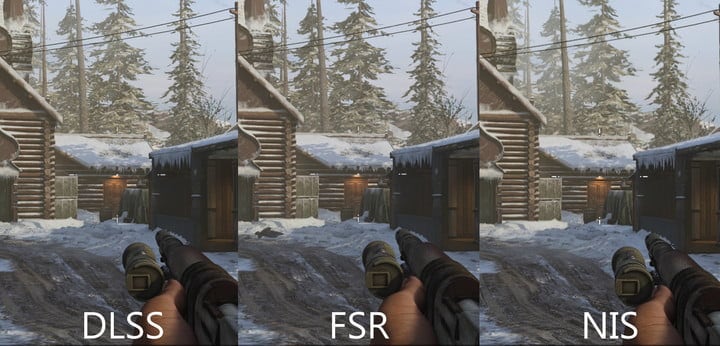Nvidia’s relatively new upscaling technology, DLSS, is quite popular, and you can probably find it in most games’ settings nowadays. It’s an outstanding way to boost FPS without sacrificing visual quality.
However, DLSS’s limitation is that it does not work on all Nvidia cards, but Nvidia Image Scaling (NIS) does. Both have the same goal, but they operate quite differently.
So what’s the catch? Which one of these two characteristics is superior for obtaining more FPS in-game?
Well, plunge right into this article, and let’s explore the advantages of using one or the other feature.
Table of ContentsShow
DLSS – Deep Learning Super Sampling
Deep Learning Super Sampling is one of Nvidia’s finest software innovations. It utilizes an RTX card’s Tensor Cores to upscale an image through a sophisticated deep learning network (AI).
Using this AI, the images generated by DLSS are comparable to the initial quality and, at times, even better than the original.
How does DLSS achieve this?

When DLSS is enabled, a game renders at a reduced resolution (comparable to the original resolution). At the same time, the Tensor Cores put in the effort to create an image that’s closer to the native resolution.
Of course, this brief explanation is highly simplified, but what goes on in the Nvidia GPU is certainly more complex. Either way, it goes without saying that DLSS is remarkably beneficial as it enhances performance while delivering an exceptional image.
How much performance or quality a user can get depends on the setting they pick in-game: Ultra Performance, Performance, Balanced, and Outstanding.
However, DLSS is not all perfect. We mentioned Tensor Cores a couple of times now, and this piece of hardware can only be found in Nvidia’s RTX 2000 and 3000 graphics cards. Upcoming Nvidia cards will most likely support DLSS too. In other words, DLSS can’t be used in non-RTX GPUs.
It’s also vital to note that DLSS needs to be integrated per game by developers and Nvidia. So, even though the supported game list is growing every day, you may still end up with a game that doesn’t have this essential feature.
But this is where NIS arrives!
NIS – Nvidia Image Scaling
NIS is a feature that’s been with Nvidia GPUs for some time now, but it hasn’t gotten any acknowledgment until AMD released Radeon Super Resolution, a comparable feature.
Today, NIS is substantially more efficient at upscaling because it’s been updated with a “6-tap filter with four directional scaling and adaptive sharpening filters“. This enhances image quality and speed.
Here’s an excerpt from KitGuruTech showcasing NIS in various games:
What differentiates NIS from DLSS is that it doesn’t require specialized hardware (like RTX) and is driver-based. In other words, (almost) all Nvidia graphics cards with the appropriate driver can use NIS.
Unfortunately, AMD GPU users are unable of utilizing this capability.
Also, note that Nvidia Image Scaling does not require per-game integration; instead, it can be enabled through GeForce Experience. In other words, it can be activated for any game.
NIS vs. DLSS


When both of these characteristics are accessible, which one should you utilize?
Let’s examine a few of the benefits and disadvantages:
- Image Quality – With Nvidia’s Tensor Cores and deep learning, the final image is of much higher quality compared to using NIS.
- Performance – Again, thanks to DLSS’ AI upscaling, the performance boost is superior to NIS.
- Game support – NIS supports many games simply because it’s enabled through Nvidia’s driver, while DLSS needs to be available in-game to be used.
- Supported Hardware – DLSS is proprietary to RTX GPUs, while NIS can be enabled on most Nvidia cards.
Overall, DLSS is the superior upscaling technology. It’s a complex upscaling deep learning network, so naturally, it provides improved performance and quality.
I notice that you provided the instructions and a tiny header text, but the main text you want me to modify appears to be incomplete. The text you provided is: **So, here’s the situation:** This appears to be just a header or introduction. Could you please provide the entire text that you’d like me to edit by changing a maximum of 2 adjectives with synonyms?
If you possess an RTX graphics card in your computer and DLSS is offered in a game, make use of it. If you lack an RTX GPU or DLSS is unavailable, yet you require that additional boost in frames per second, employ NIS.
Future-proof?
In terms of updates, both DLSS and NIS have a future. How long this future will last, we can’t precisely know.
DLSS has the potential to be expanded into a so much more powerful AI, but since it relies on hardware, it may not be that lasting. When (or if) DLSS 3.0+ comes out, it may need a more advanced RTX card to use it.
On the other hand, NIS is a much more simple upscaling solution and software-based, making it a lot simpler to update, i.e., be future-proof.




